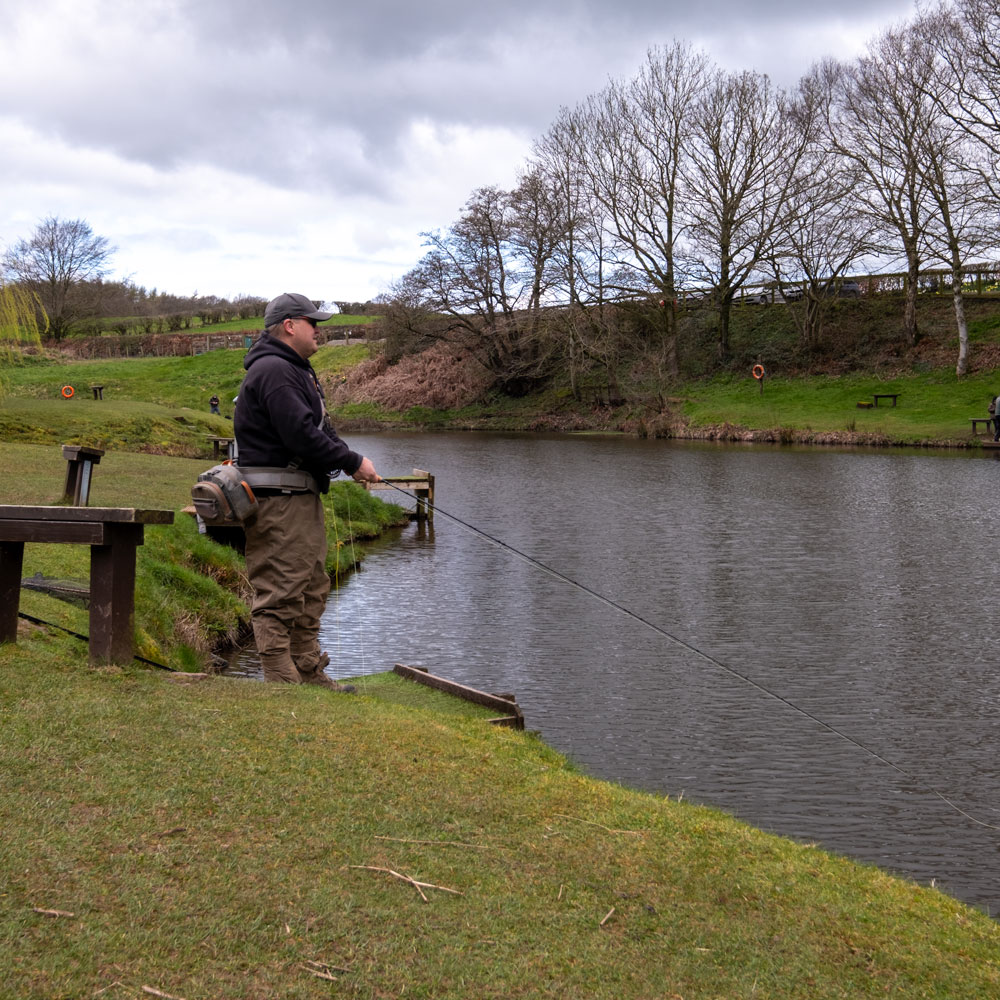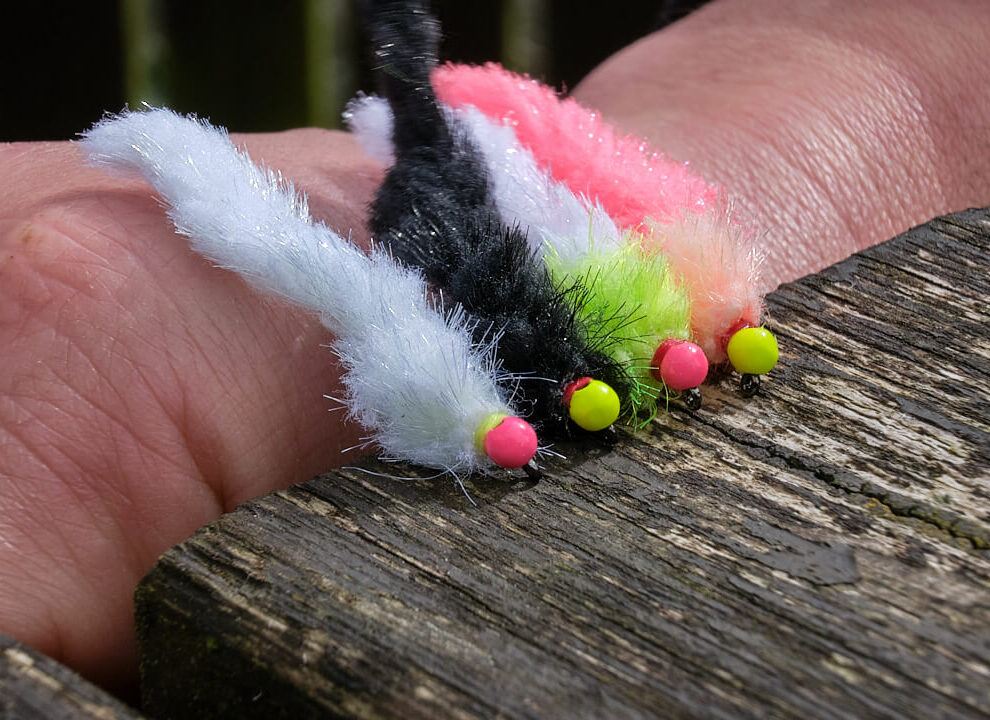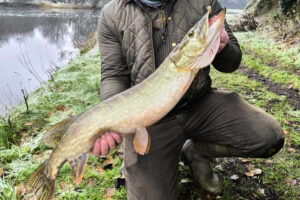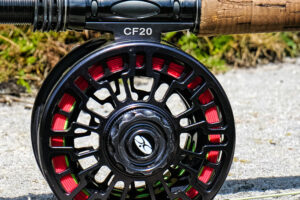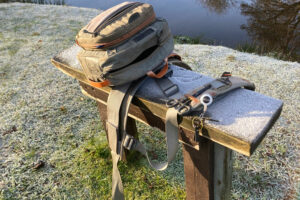When you’re asked to compile a list like this, it’s an impossible task.
Everyone who reads this will immediately think they’d take that fly out and put that one in. I’d probably change it myself every week. But it’s a good starting point and an overall nudge in a general direction of fly patterns, rather than a cast iron statement of one being superior to another.
Let’s class winter as December, January, and February. Possibly carrying on into March depending on the weather.
The lakes are in a bit of a slumber insect wise at this time of year, but that’s not to say there’s no trout food on the move. One given is that there will always be some stage of Midge knocking about in the form of bloodworm, the buzzer pupae or the adult midge.
Any little rise in temperature can bring things on the move, so while dry fly-fishing is largely on the back burner, there might be small windows, especially in the middle of the day when things warm up. Never say never, but for the most part, we are probably going to be fishing subsurface in winter.
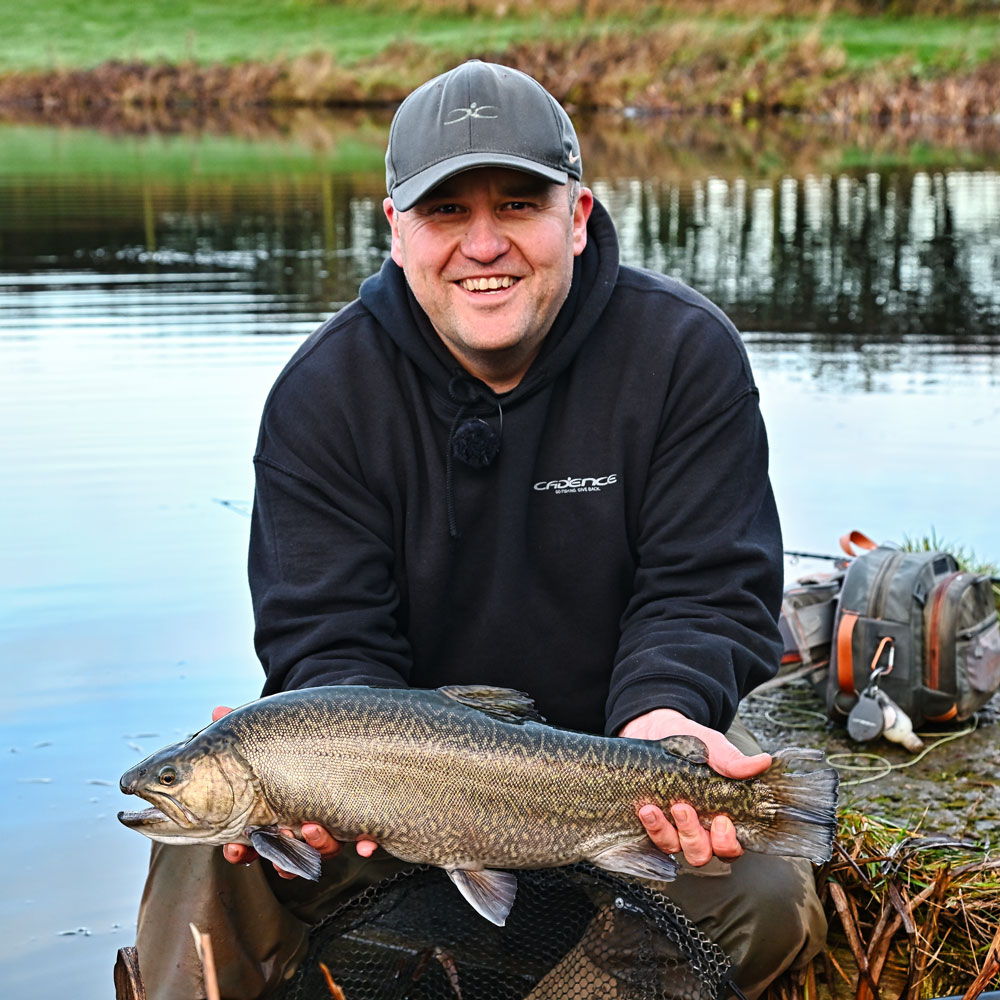
The other thing to consider is that trout are very comfortable in cold water. Far more than in the heat of the summer. So they will be active at certain times of day, for sure. And if they are active, they are more likely to chase.
One other factor is that that fisheries would tend to stock more fish more regularly in the winter than in the summer.
In summer, the water can be so warm, any new fish would just keel over the second they are put in the lake. So fishery managers have to be careful when the fish go in. There aren’t as many windows of opportunity to stock fish, simply put. This especially applies to bigger fish, so winter is probably your best chance of getting a personal best.
With the injection of newer fish, there is also the likelihood they don’t behave as naturalised fish so much. They will have their heads turned by more gaudy looking flies with more sparkle and pop than you might fish in the summer.
Top Flies for Winter
- Mini Snake – 5 cm
- Slushy Bug
- Blob
- Cats Whisker
- Cormorant
- Black Buzzer
- Egg Fly
- Wotsit
- Black and Green Tadpole
- Apps Pulling Worm
Mini Snake – 5 cm
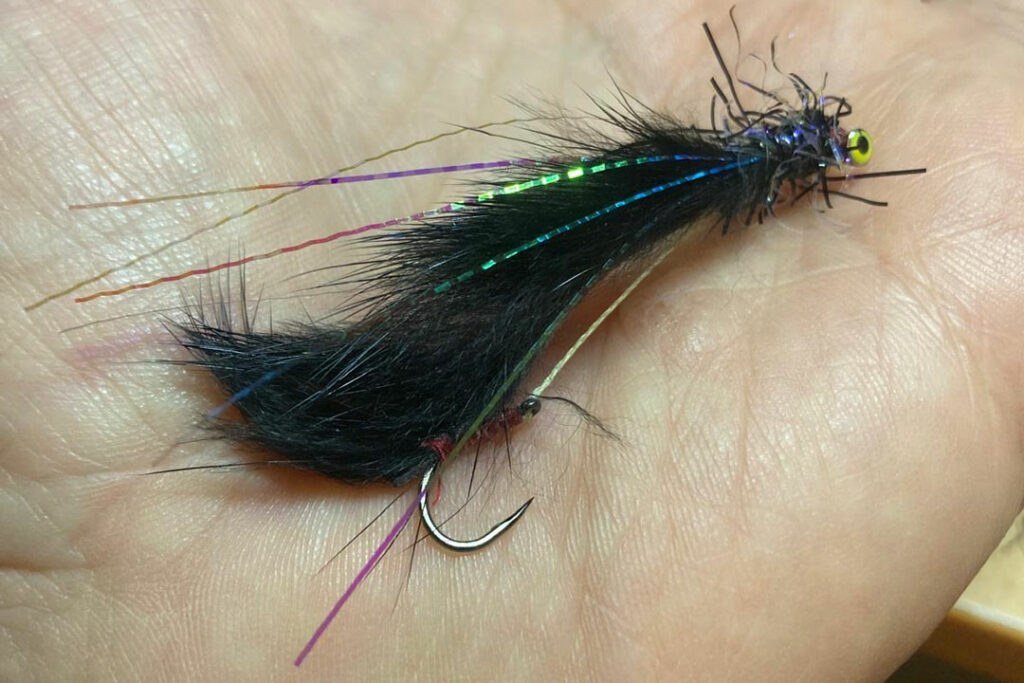
The sinking line rod will invariably start off with a Black Mini Snake. My favourite is to have black fur, luminous green plastic (unweighted) eyes and a blue straggle hackle around the neck area. With one or two strands of krinkle flash underneath (this stuff really stands, so don’t go overboard adding half a hank).
Barred Olive with blue straggle is another great one, and I wouldn’t be without a white and chartreuse Cats version either. I’ve seen and used all manner of colours, but these three will do you for starters. If I only had a choice of one, it would be black.
Think about what you have in the head as well. Weighted or unweighted, basically. Double bead or single bead, as some people think a single bead presents the fly better. It’ll certainly balance better than a double bead tied on wonky.
For fishing sinking lines, I will tend towards an unweighted version on a shortish leader of 10-12ft. The thinking being the line will take the fly down, but when it’s near the bottom it will ‘bounce’ up a little more than a weighted fly and not snag up quite so easily.
I also love fishing snakes ultra-slow, so the unweighted version helps here.
There’s enough pulse in the fur to make the thing look alive, no matter how slow you retrieve, and the takes can be seriously hard when bringing it back at a snails pace.
If you fish it on a floating line, a weighted version might be more beneficial to help the fly bite down a little, but try both as the fish may only want to take in the top few inches.
Whichever version you choose, snakes are really good fun to fish and can generate responses that you wouldn’t get with any other fly. It’s an aggressive and territorial type of response in numerous instances. The fish won’t always take, but they’ll definitely be aware and most likely come to have a look.
Three pointers to note when fishing these flies. Firstly, give them an exaggerated hang before lifting off to cast again. The number of fish that have seen them off the premises through the retrieve but get caught out by the fly not being lifted off is high. If the water is clear, you can see the confusion, and quite often they’ll do a circle and come back and inhale the hanging fly. By exaggerated, I’m talking 8 or 9 seconds. And watch the hanging line like a hawk. These takes can be very gentle, and you might just see it twitch, but be ready.
The second point is that a snake can shut an area down rapidly and put the fish on guard. You might get a response straight away and then a couple of nips, but there is no fly like this for quietening things down quickly. Not always the case, but keep an eye out for this happening and be prepared to move or at least change flies regularly.
The third is it’s not always the best hooker first and foremost – you will get lots of taps and bangs and the line won’t always lock up. You can also lose more fish than on a normal fly – maybe because of the slightly less reliable hook position combined with leverage?
Slushy Bug
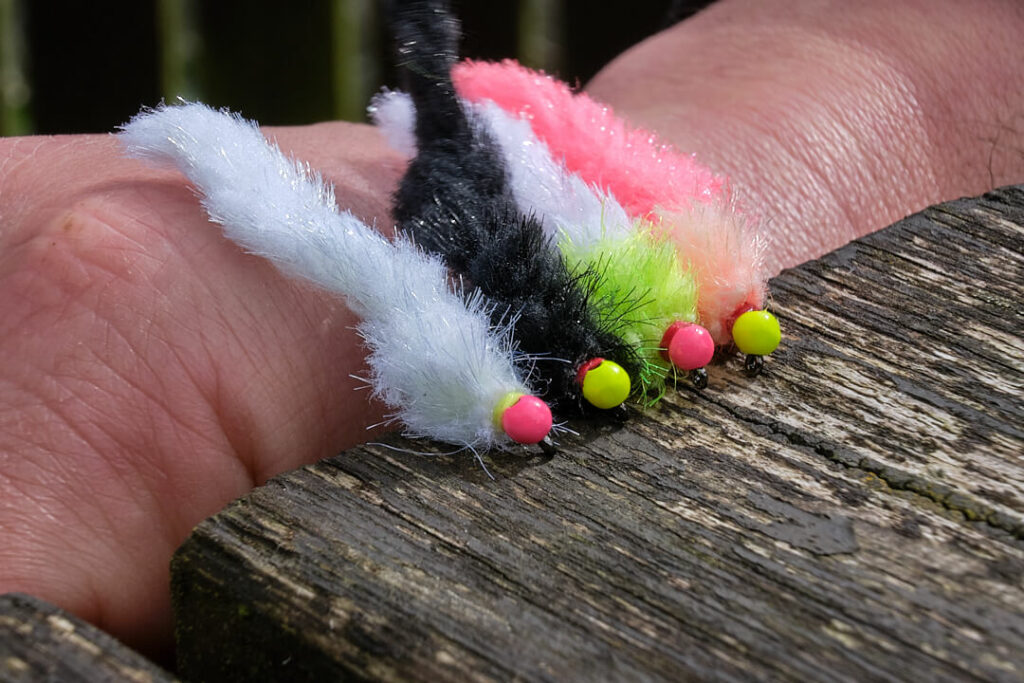
My go-to tail fly for fishing under an indicator. This is my version of an Eggstacy Worm but using FNF Slush Jelly instead of Eggstacy. It’s tied on a jig hook with a 3.5 mm tungsten bead and fished under an indicator I designed and make myself.
Both are great materials, but the FNF Slush just holds a little more rigidity when using tails on a pattern and tangles round the bend far less. Which is nice to know if the flies are likely to be out for a long soak between casts. It also comes alive in water and pulses almost like a mini snake when not being retrieved.
If you only have Eggstacy and tie flies yourself, just whip in a loop of old leader line near the bend of the hook that will stop the material collapsing over the hook. I use both materials and over time, the best FNF Slush is called ‘Blue Cheese’ but I’m also pretty happy with the Peach Eggstacy version. There are loads of colours to try out, though. Black is always a good Plan B and I have a couple of friends that swear blind the Spearmint Mojito Eggstacy is on another level.
One point to note when tying the tail on is don’t get too carried away. I put mine in so they are 1.25in in length – measured from the bend of the hook. Once FNF Slush is wet through the tail length will increase quite a bit so consider it will be different when you fish it from what left the vice.
You can also double this fly up as a pulling fly with a few tweaks: Increase the tail length ¼ to ½ of an inch. And certainly drop the bead weight a little. Maybe 3.0 mm and under in tungsten terms. I also tie it on conventional hooks rather than jig hooks for pulling. About a size 10. Fish as fast or slow as you would with a standard lure.
And one thing is for sure with Slush – the material looks far better in the water than in a fly box, where it can look quite uninspiring.
Blob
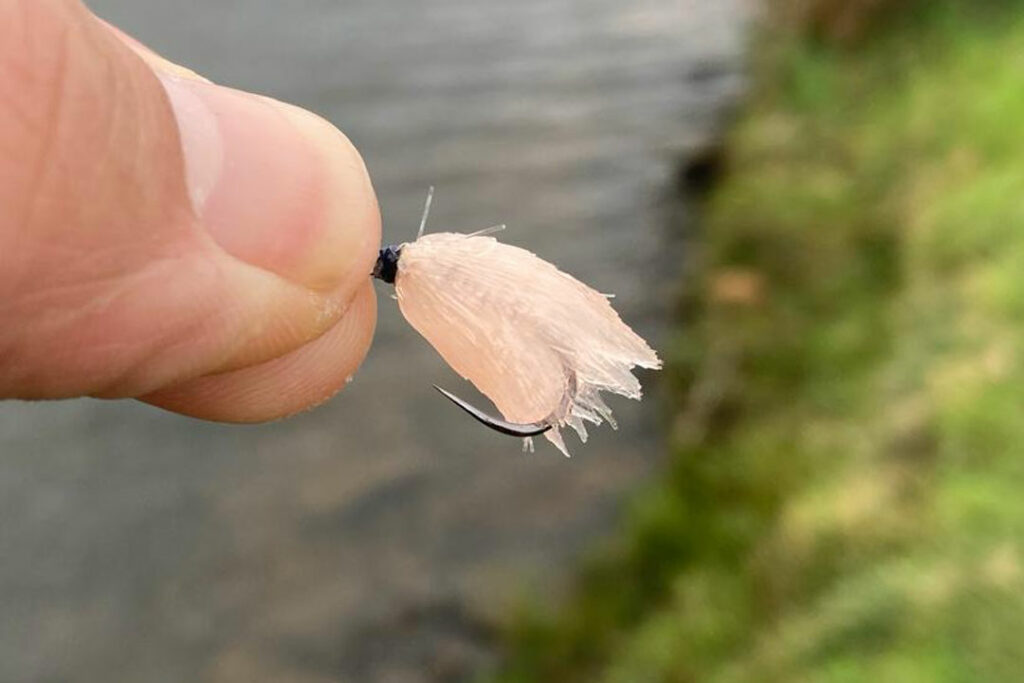
Dead straightforward to tie and a favourite with the trout in a huge range of colour combinations. They’re also super versatile to fish – unlike many flies.
First and foremost, you can use a team of them pulling. I think this was the use they were originally designed for.
You could use one on the top dropper to draw fish to the area, but have a more natural nymph in behind to give them something more natural if they refuse the top fly. They’re a great attention grabber.
Blobs can also be used fished static under an indicator.
And then there’s the ultra-slow retrieve with a single Blob on a long leader of 15-20ft. This can be a lethal method when the fish are very hard to catch.
The long leader keeps the flies out of sight of the fly line, which can scare the fish. It will also bounce around more naturally than a weighted fly on a sinking line and keep clear of the bottom, similarly to the snake mentioned above.
Whichever method you choose, you absolutely must have a few Blobs in your box. And don’t rule out going right down in size with a smaller fritz as well. Tiny Size 18’s can out fish the more familiar size 10s, but maybe more so in summer.
Colour is a personal choice – the most popular ones seem to be in the yellowy/orange hues. Look out for Tequila and Candy. Or just straightforward Orange, Biscuit, Yellow or Black.
You can also hide a foam tail in the standard Blob and turn it into a FAB. Or a Foam Arsed Blob. These do a phenomenal job of keeping your other flies in the upper layers – in basic terms, you have a FAB on the point and floating line at the other. Both float, meaning the dropper/s between cannot sink as deep as they would if you had a weighted fly on the point. You might be able to work out why this is called the washing line method. Do not rule this out in the winter as the fish can be very high up, even if they aren’t rising.
Cats Whisker
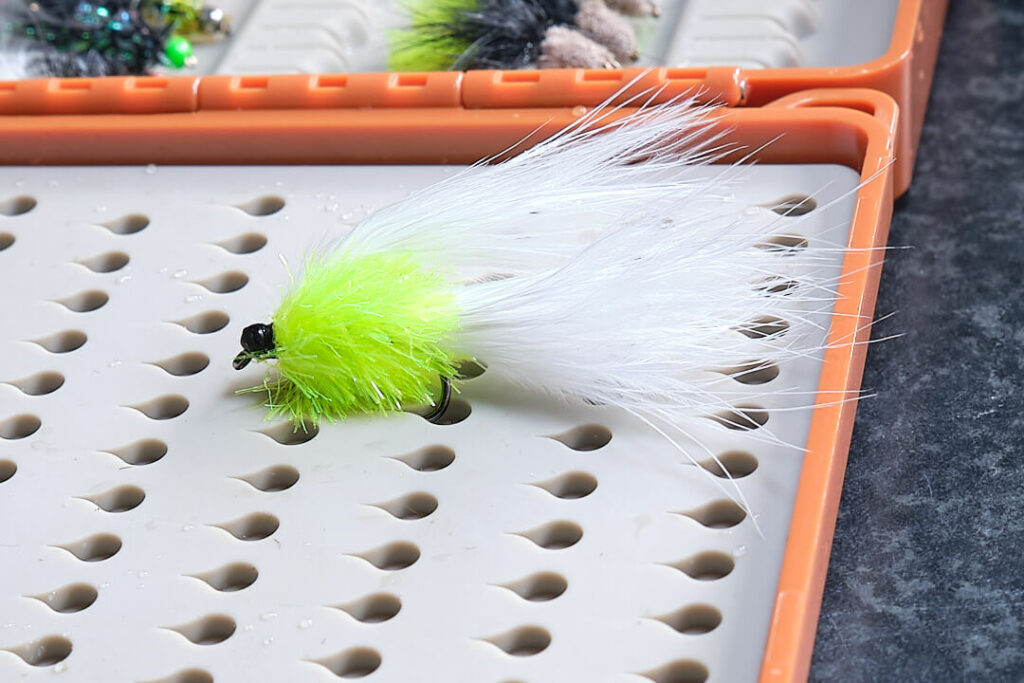
An old but proven fly that’s stood the test of time in one of the classic colour combinations of white and chartreuse.
Most of the Cats Whiskers I fish with have a bead chain eye tied underneath the hook. If you tie it on top of the hook, gravity will mean the fly fishes upside down, which is up to you.
The Cats Whisker was a change from the popular tadpoles because it didn’t just have a Marabou tail, it also had a marabou wing, meaning movement and pulse were doubled.
From memory, I think the original was tied with a stiff material mixed in with the marabou to stop it wrapping so much. Something resembling a cats whisker, strangely enough. Although, I think the material used was something like old monofilament? Or there’d be a lot of low sensitivity cats.
Either way, I’ve always done great with this fly fished on an intermediate line and 14ft leader. Cast out, let it turn over and let it sink for a few seconds before starting a figure of eight retrieve. The takes regularly come on the drop or the first couple of seconds of the retrieve. You’ll also get them on the retrieve or on the hang.
One final thing – a black version with a Mosaic fritz is lethal. It’s not technically a Cats Whisker, but it’s tied in the same style. But with black marabou tail and wing and mosaic body.
If I had room for one more ‘old-fashioned’ lure, I’d go with an Appetizer, even though it was the Viva that reigned supreme back then.
Cormorant
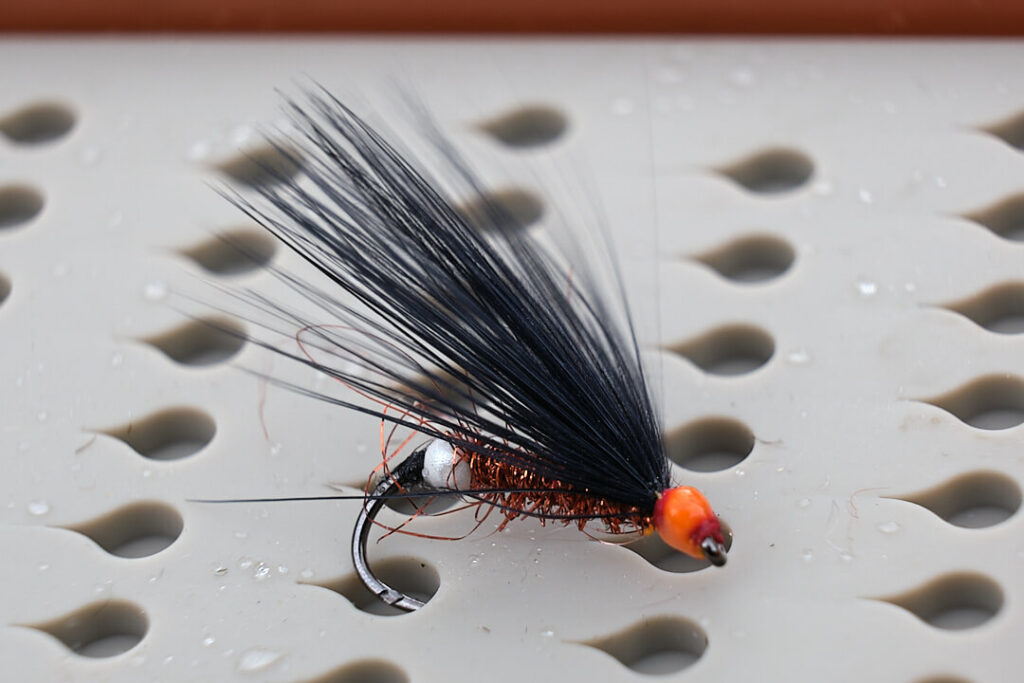
Essentially, a very small lure without a tail, the Cormorant was originally tied with the tips of the leftover marabou from the part of the feather no-one used on normal lures.
There are so many variations but in summary a Cormorant is a combination of natural and attractor. They are often used as droppers on a team of flies. But you can fish them single on a long leader.
The marabou wing gives a little more movement than a standard wet fly, and you can put a bit of weight in the head or the tail to make it kick a little more between pulls.
A great all-rounder if the fish are sick of seeing bigger flies pulled back all the time. A great fly even if they haven’t.
Black has definitely been the most popular colour. Perhaps with a pearl tinsel body, but there are so many variations, it’s untrue. But it is basically a standard wet fly hook with marabou wing that doesn’t go much beyond the bend of the hook. Often seen in the middle of a washing line set up.
Black Buzzer
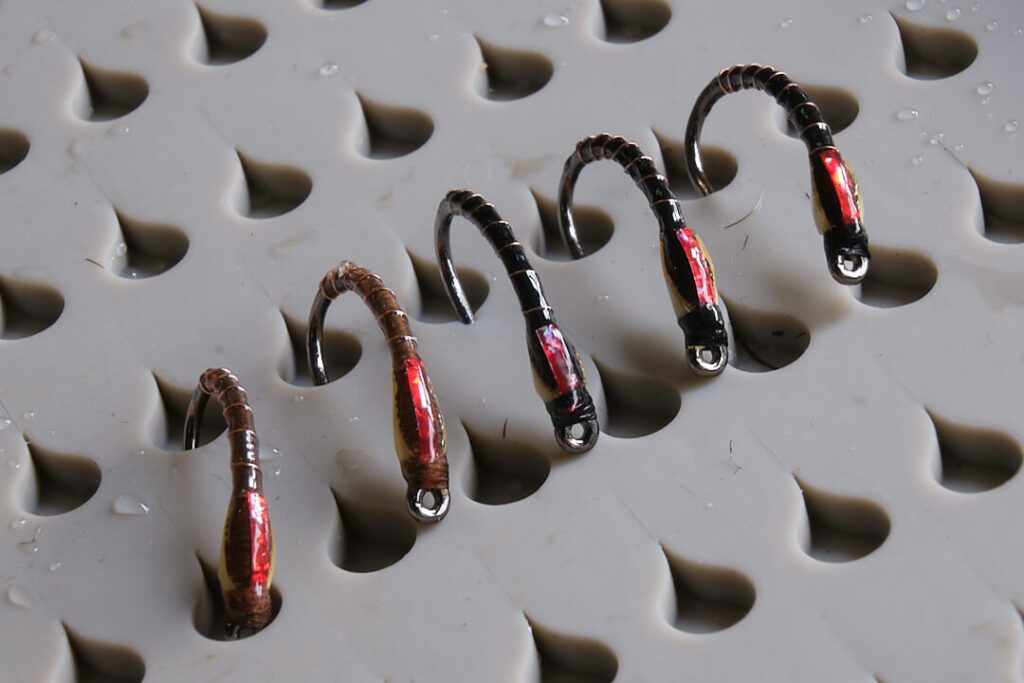
It might not be prime buzzer season, but it’s probably the natural food the fish will eat the most over winter. And black is likely to be the most popular colour.
As most people will be pulling bright lures, this is a great alternative to catch the fish off guard as they shy away from the gaudy stuff.
Fish it in the normal buzzer style with a cast diagonally downwind and let it drift slowly. Or fish it as a dropper under an indicator.
And keep it simple. Black with a basic wire rib and orange cheeks should do fine.
Many people still like lots of flash and sparkle on buzzers to make them stand out, but I think in this case, subtle and sombre is best.
You would struggle to get much better than a Wicked White, in all honesty. Black thread with a white dot at the head coated in varnish. Simple but very, very effective.
If the fish are high up in the water, which they very often are in winter. A Black Buzzer on a washing line set up would become one of the best methods on a lot of lakes, so keep in mind the naturals.
Egg Fly
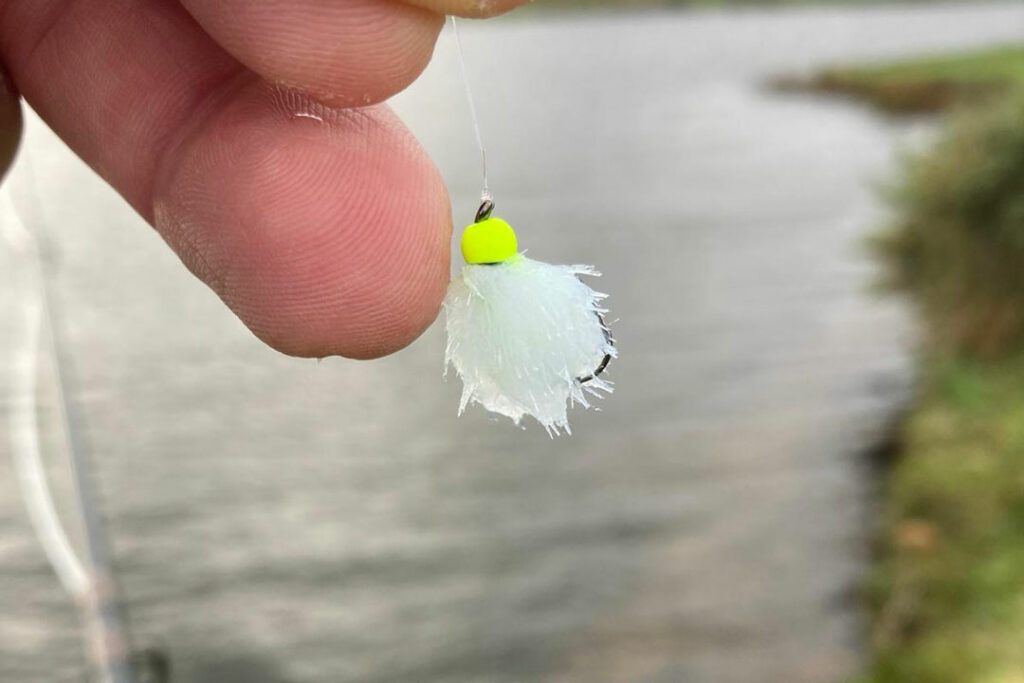
It doesn’t matter if the fish are stocked or as wild as the hills. They all have an instinct built in to their DNA that means they’d tune into fish eggs instantly.
Perhaps a single egg fly isn’t going to get them going in the same way as a spawning fish, but it’s a step in the right direction.
And it’s a nice, easy to eat little mouthful that catches a load of fish under an indicator. This is the Egg Flies specialist role.
I’m not even convinced fish see them as eggs, though. Maybe just a little morsel drifting around on the current that looks more edible than a big marabou lure?
Whatever it is taken for, they are pretty lethal and so simple to tie it’s untrue.
The clue is in the name, but Eggstacy is a great material for these. Some people put a little dab of red marker in the middle of a peach body to really try to look like an egg. But any colour can work.
And if there’s one thing to go with here is, don’t just fish the conventional Size 10 or 12. Think seriously about dropping the overall size right down here. Potentially down to an 18.
Wotsit
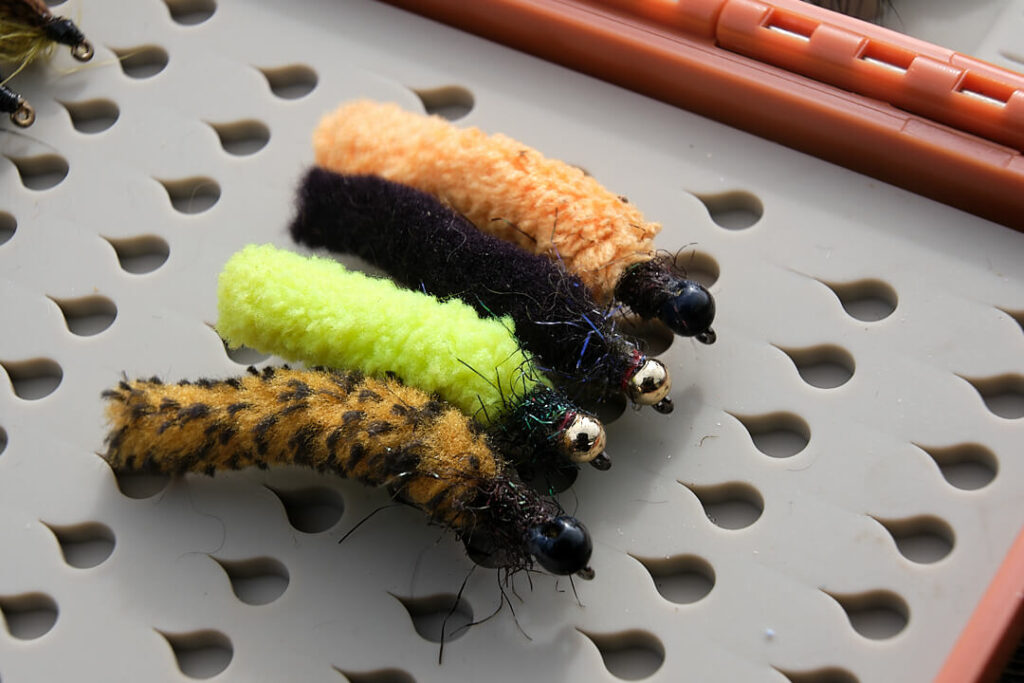
Or Mitten Fly. Or Mop Fly.
I’m fully aware this has hardly been a list to make the traditionalists proud. But this one will have them gasping.
If you don’t already know what this is, think of a car washing mitt. You know, the ones with all those little fingers sticking off?
Well, a Wotsit is one of those fingers tied onto a hook.
When they first came about, people used to hook them on like a worm in the USA, I believe. Which might be going a little too far in the purity stakes. It’s hardly fly tying, is it?
I try to make an effort with the mine by tying them with picked out dubbing and such like around the collar area. But the fact remains, the main attractor is that soggy little digit. It can be lethal and, like the snake, can generate a response you haven’t really seen before with more standard flies.
Similar to the Cats Whisker, fish it on an intermediate and let it sink before starting a figure of eight retrieve. You can definitely catch when stripping it fast as well.
And if you really want to burn in hell, fish it under the bung.
Black and Green Tadpole
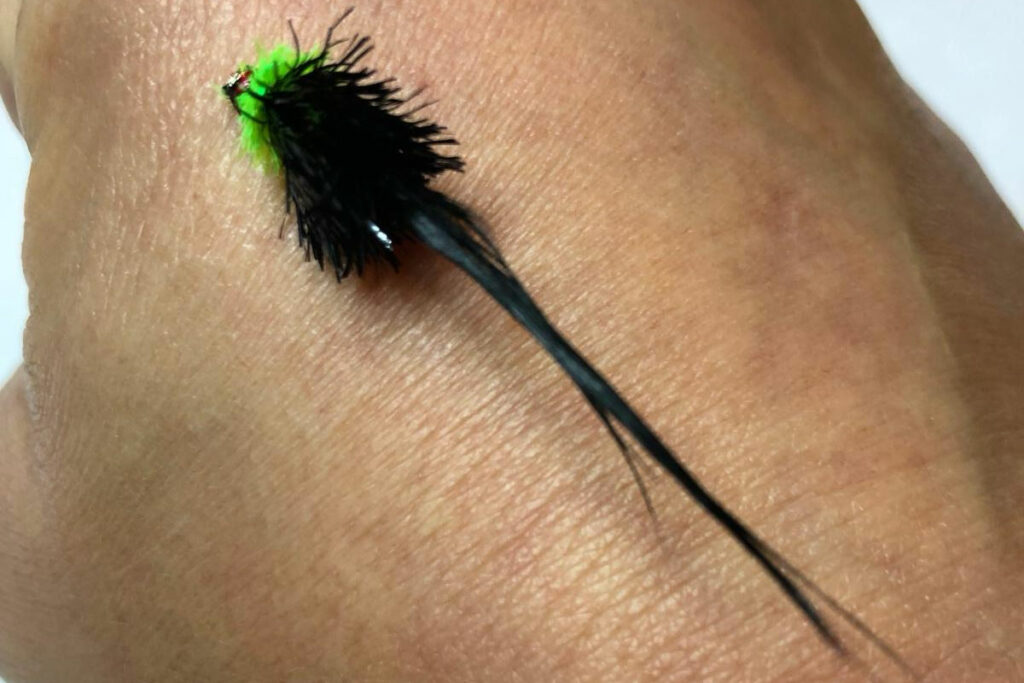
Many moons ago, it was found out that Black and Green was a pretty handy combination for cold water trout fishing. That remains true to this day.
It might not be original or flash, but you will struggle to beat the good old basic taddie for Winter fishing.
It’s got the weight in the head to make it sink and draw attractively, It’s got the long tail to make it look alive, and then it’s got the contrasting green point somewhere on the body to catch the eye.
It’s really easy to tie as well.
This is your bread and butter winter trout fly, and it’s been around for ages for a very good reason.
Once again, the intermediate line is great with various sinking times and a complete mixed bag of retrieves. A straightforward strip style will put the short pauses in that will make it drop down before the pull lifts it up and makes that tail wink at the fish.
Fish it by itself or put a dropper above with a Blob on, and you won’t go too far wrong.
Apps Pulling Worm
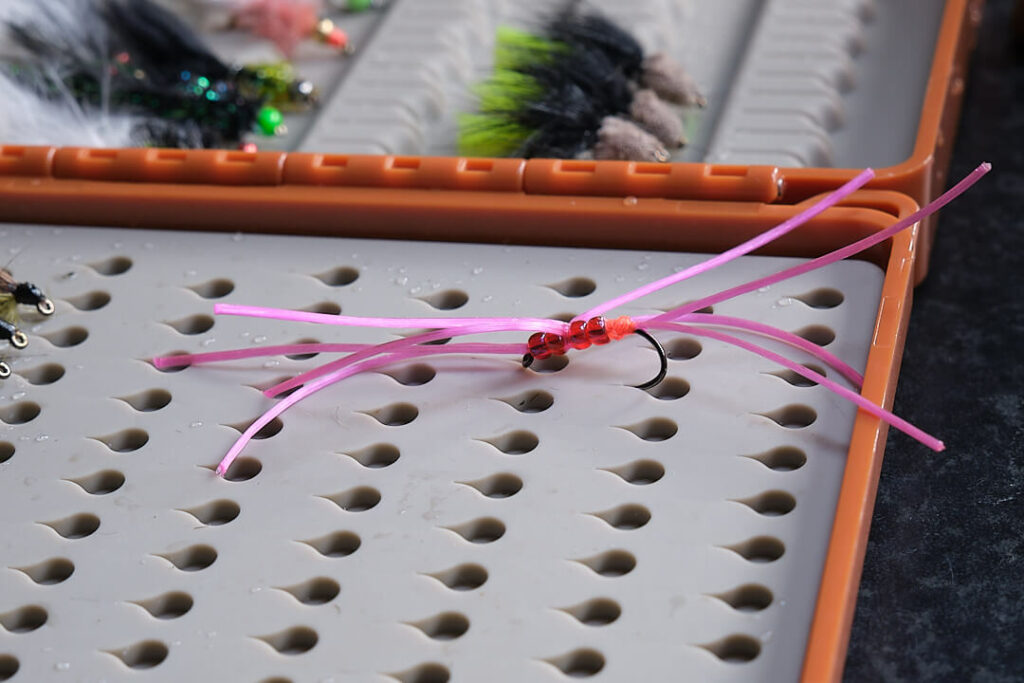
Roughly every 10 or 15 years, there is one fly that stands above and beyond all comers on its own. An untouchable.
When I started fly-fishing, it was the Viva.
And then the Cats Whisker. Followed by the Blobs. And jam in Diawl Bachs somewhere as well.
The past few years, it’s been the Apps Worms. There are many variations, but perhaps the most used is the Olive Pulling Worm. Or maybe the Amber version?
Regardless of exact details, they are lethal and proven by the number of competitions won with them. These aren’t just flash in the pan flies. They are time served proven winners, designed by a time served proven winner.
Book Stuart for a Lesson
Stuart is a fully qualified fly-fishing instructor available for half or full-day lessons. He can also tie flies to order, but these are strictly limited and may take a while as they are all personally tied and not bought in.
To book a lesson or make an enquiry, contact him through his Facebook page here:
https://www.facebook.com/profile.php?id=100094263695351
Email: stuart@cadencefishing.co.uk
